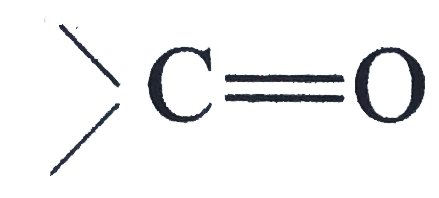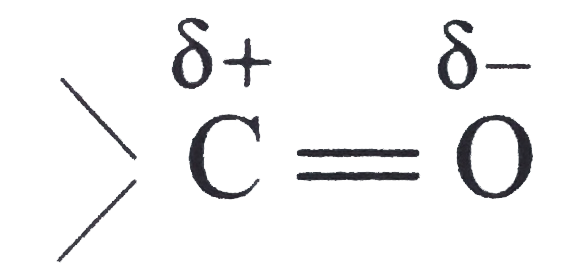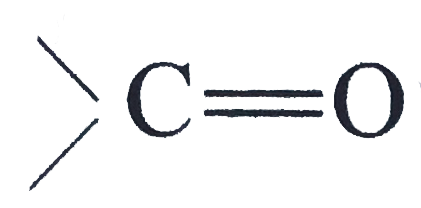Complete Solutions to PASSAGE 1 of chapter ALDEHYDES AND KETONES of Class 12 book with complete answers and questions
| Class 12 | CHEMISTRY |
| Chapter | ALDEHYDES AND KETONES |
| OP TANDON | PASSAGE 1 |
| Number Of Questions | 5 |
| Academic Year | 2023-24 |
Aldehydes and ketones ar specially susecptible to nucleophilic addition because carbonyl group
 is polar (due to electronegativity difference between carbon and oxygen)
is polar (due to electronegativity difference between carbon and oxygen)

Positive charge on carbon makes it reactive towards the nucleophili. This addition is catalysed by acid.
Reactivity of carbonyl compound towards nucleophilic addition increases with increases in the electron deficiency at carbonyl carbon. Thus, (-I.E.)groups increase while (+I.E.) groups decrease the reactivity of carbonyl compound.
Which among the following is most reactive to give nucleophilic addtion ?
View SolutionAldehydes and ketones ar specially susecptible to nucleophilic addition because carbonyl group
 is polar (due to electronegativity difference between carbon and oxygen)
is polar (due to electronegativity difference between carbon and oxygen)

Positive charge on carbon makes it reactive towards the nucleophili. This addition is catalysed by acid.
Reactivity of carbonyl compound towards nucleophilic addition increases with increases in the electron deficiency at carbonyl carbon. Thus, (-I.E.)groups increase while (+I.E.) groups decrease the reactivity of carbonyl compound.
Carbonyl compounds show nucleophilic addition with :
View SolutionAldehydes and ketones ar specially susecptible to nucleophilic addition because carbonyl group
 is polar (due to electronegativity difference between carbon and oxygen)
is polar (due to electronegativity difference between carbon and oxygen)

Positive charge on carbon makes it reactive towards the nucleophili. This addition is catalysed by acid.
Reactivity of carbonyl compound towards nucleophilic addition increases with increases in the electron deficiency at carbonyl carbon. Thus, (-I.E.)groups increase while (+I.E.) groups decrease the reactivity of carbonyl compound.
Which among teh following carbonyl compounds is most pola?
View SolutionAldehydes and ketones ar specially susecptible to nucleophilic addition because carbonyl group
 is polar (due to electronegativity difference between carbon and oxygen)
is polar (due to electronegativity difference between carbon and oxygen)

Positive charge on carbon makes it reactive towards the nucleophili. This addition is catalysed by acid.
Reactivity of carbonyl compound towards nucleophilic addition increases with increases in the electron deficiency at carbonyl carbon. Thus, (-I.E.)groups increase while (+I.E.) groups decrease the reactivity of carbonyl compound.
Select the least reactive carbonyl compound for nucleophilic addition :
View SolutionAldehydes and ketones ar specially susecptible to nucleophilic addition because carbonyl group
 is polar (due to electronegativity difference between carbon and oxygen)
is polar (due to electronegativity difference between carbon and oxygen)

Positive charge on carbon makes it reactive towards the nucleophili. This addition is catalysed by acid.
Reactivity of carbonyl compound towards nucleophilic addition increases with increases in the electron deficiency at carbonyl carbon. Thus, (-I.E.)groups increase while (+I.E.) groups decrease the reactivity of carbonyl compound.
Which among the following isomeric compounds is most reactive?
View Solution
PASSAGE 1 questions and complete solutions for chapter ALDEHYDES AND KETONES of G.R. BATHLA & SONS CHEMISTRY (HINGLISH) of Class 12
All Exercises from OP TANDON Class 12 CHEMISTRY ALDEHYDES AND KETONES
- ASSERTION-REASON TYPE QUESTIONS
- BRAIN STORMIN PROBLEMS
- ILLUSTRATIONS OF OBJECTIVE QUESTIONS
- MATCHING TYPE
- MATRIX-MATCH TYPE QUESTIONS
- OBJECTIVE QUESTIONS (LEVEL -A)
- OBJECTIVE QUESTIONS (LEVEL -B) SET I
- OBJECTIVE QUESTIONS (LEVEL -B) SET II
- PASSAGE 1
- PASSAGE 2
- PASSAGE 3
- PASSAGE 4
- PASSAGE 5
- PASSAGE 6
- PASSAGE 7
- PASSAGE 8
- PROBLEMS BASED ON STRUCTURE AND PROPETIES
- PROBLEMS FOR PRACTICE
- SINGLE INTEGER ANSWER TYPE QUESTIONS
- SOME SOLVED PROBLEMS